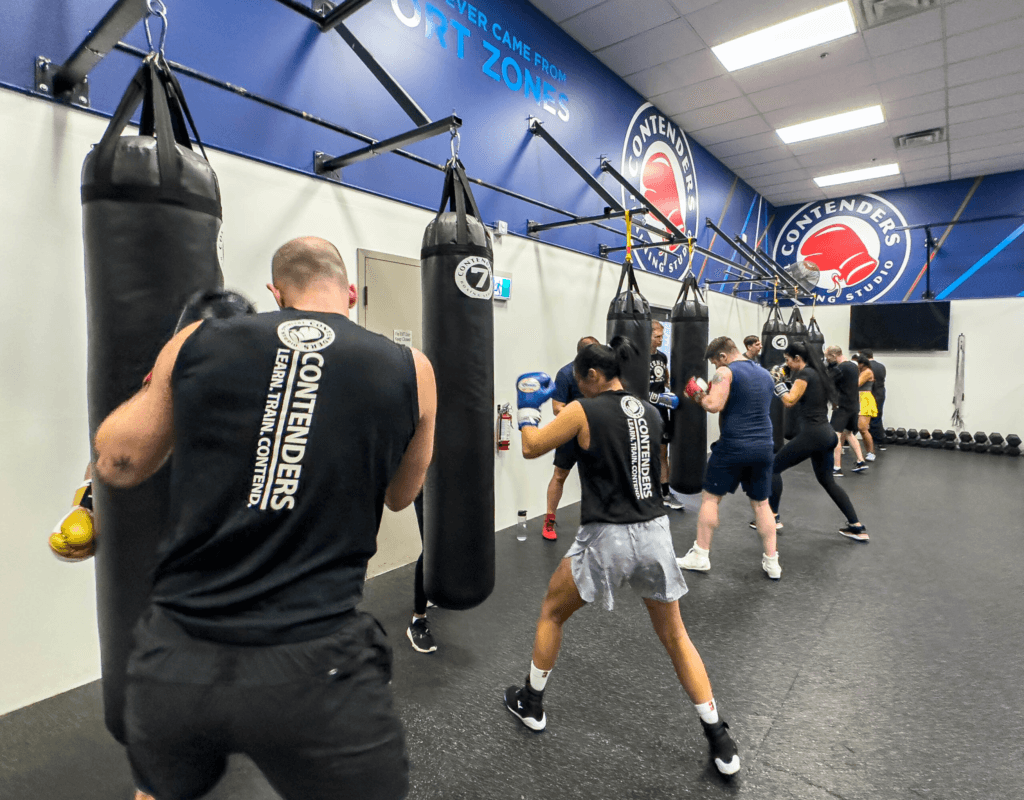When Muhammad Ali first stepped into a boxing gym at age 12, he wasn’t “The Greatest” – he was just a kid. Today, you might be standing where he once stood, wondering how to start your own boxing journey. After spending years in boxing, I’ll show you exactly what it takes to become a boxer in 2025.
Understanding What You’re Getting Into
Let’s be clear – boxing isn’t just another workout routine. It’s a demanding sport that requires serious dedication and discipline. You’ll need to train 4-6 days a week, push through challenging sessions, and maintain strict discipline with both training and diet. But if you’re ready to put in the work, boxing will transform not just your body, but your entire mindset.
Finding Your Boxing Gym
The most crucial first step in how to become a boxer isn’t throwing a punch – it’s choosing the right gym. This decision will shape your entire boxing career, so let’s get it right.
A proper boxing gym isn’t just a fitness center with some punching bags. When you walk in, you should immediately notice a few key things. First, there should be a regulation boxing ring – not just a training area with some bags hanging from the ceiling. You should see various types of equipment: heavy bags, speed bags, double-end bags, and proper training areas. Most importantly, you should see real boxers training with experienced coaches.
What Makes a Great Boxing Gym
During your search, pay attention to these crucial elements:
The coaching staff should be actively engaged with fighters, not just supervising general workouts. Look for coaches who take time to explain techniques and make corrections. You want to see a mix of skill levels training – from beginners learning the basics to amateur competitors preparing for fights.

Watch a complete evening training session if possible. This is usually when the serious fighters train, and it’ll give you the clearest picture of the gym’s quality. Pay attention to how coaches interact with different skill levels and how they maintain safety during sparring sessions.
Red flags to watch for:
- Gyms focusing mainly on fitness boxing
- Coaches who can’t demonstrate proper technique
- Pressure to spar before you’re ready
- Lack of proper safety protocols
- No competitive fighters training there
Becoming a Boxer: Your First 6 Months
Let’s break down exactly what your boxing journey will look like in the beginning. I’ve seen too many beginners quit because they didn’t know what to expect – let’s make sure you’re prepared.
The First Month: Building Your Foundation
Your initial weeks will focus entirely on the basics. You’ll spend a lot of time just learning how to stand properly and move. This might seem tedious, but these fundamentals will become your lifeline in the ring.
A typical first-month session might look like this:
- Warm-up and stretching (15 minutes)
- Footwork drills (10 minutes)
- Basic punches (20 minutes)
- Conditioning work (20 minutes)
- Cool-down and technique review (10 minutes)
Months 2-3: Expanding Your Arsenal

Once you’ve got the basics down, your training will expand significantly. You’ll start learning advanced punches, basic defensive movements, and proper combination work. Your conditioning will intensify, and you’ll spend more time on the heavy bag and speed bag.
During this phase, you’ll also learn the crucial skill of proper breathing while punching. Many beginners hold their breath – a mistake that will leave you exhausted in the ring. Your coach should be teaching you how to breathe with each punch and movement.
Months 4-6: Technical Development
This is where things get interesting. You’ll start putting everything together: combinations, defensive movements, footwork patterns, and ring strategy. Your conditioning will reach new levels, and if you’ve shown proper dedication and technique, you might start with some sparring.
Remember: sparring isn’t about trading heavy shots. It’s about applying what you’ve learned in a controlled environment. A good coach won’t let you spar until you’ve demonstrated proper defensive skills and control.
Essential Equipment Guide
Let’s talk about what you actually need to start boxing and become a boxer for real. I’ve seen too many beginners waste money on unnecessary gear, so I’ll break down exactly what you need and when you need it.
Day One Essentials
- Hand Wraps Your hands are your tools – protect them properly. You’ll need at least 2 pairs of hand wraps (180 inches long). Learn to wrap them properly; proper hand protection is crucial for longevity in boxing.
Read More: How to Wrap Your Hands for Boxing - Boxing Gloves Invest in a good pair of 16 oz training gloves. Yes, quality gloves are expensive, but they protect your hands and last longer. Look for:
- Proper wrist support
- Good padding distribution
- Quality leather construction
- Secure closure system
Read More: How to Choose Your First Boxing Gloves
- Mouthguard Never skimp on mouth protection. A custom-fitted mouthguard is best, but a quality boil-and-bite guard is fine for beginners. Get a spare – you’ll thank me later.
For equipment, I would say RDX has a very good quality to price ratio. If you’re interested you can use code “PUNCHHIVE10” for 10% off your order.
Second Month Additions
As you progress, you’ll need:
- Jump Rope A crucial tool for footwork and conditioning. Get a speed rope for skill development and a weighted rope for conditioning.
- Boxing Shoes Once you’re committed to training, proper boxing shoes make a huge difference. They provide:
- Better grip for pivoting
- Ankle support for quick movements
- Lightweight design for faster footwork
- Protective Gear When you’re getting close to sparring, you’ll need:
- Headgear with good visibility
- Groin protector
- Competition hand wraps
- Speed bag gloves for skill work
Building a Fighter’s Body

Becoming a boxer demands a unique kind of fitness that you won’t get from general workouts. The ability to explode with power in round 10 requires specific training methods that I’ll break down for you.
Roadwork: The Foundation of Boxing Fitness
Every serious boxer starts their day with roadwork. Here’s how to build your running program:
Week 1-2: Start with 1-2 miles at a steady pace, two times per week. Focus on consistency rather than speed.
Week 3-4: Increase to 2-3 miles and add basic intervals. Try 1 minute of faster running followed by 2 minutes at regular pace.
Week 5-8: Graduate to training like a fighter:
- Monday: 2-3 miles steady pace
- Wednesday: 2 miles with sprint intervals
- Friday: 2 miles hill running
Read More: How to Build Stamina for Boxing
Gym Work: Building Boxing-Specific Strength
If you want to become a boxer, your strength training should focus on explosive power and endurance rather than bulk. Here’s a fighter’s strength routine:
Monday/Thursday:
- Plyometric push-ups: 3 sets
- Medicine ball throws: 4 sets
- Bodyweight/lightweight squats: 4 sets
- Core rotation work: 3 sets
- Pull-ups: As many as possible in 3 sets
Tuesday/Friday:
- Focus on technique and bag work
- Shoulder endurance drills
- Speed bag training
- Double-end bag work
Read More: How to Punch Harder
Nutrition for Boxing
Proper nutrition isn’t just about making weight – it’s about performing at your best. Let me break down a boxer’s diet plan.
Daily Nutrition Blueprint
Your body needs clean fuel to perform. Here’s what a typical day should look like:
Breakfast:
- Oatmeal with banana and honey
- 3 eggs
- Whole grain toast
- Green tea or black coffee
Pre-Training Meal (2-3 hours before):
- Potato or rice
- Lean protein (chicken/fish…)
- Green vegetables
- Plenty of water
Post-Training:
- Protein shake within about an hour
- Light meal within 2-3 hours
- Focus on replenishing glycogen stores
Evening Meal:
- Lean protein source
- Complex carbohydrates
- Abundant vegetables
- Healthy fats (avocado, nuts, olive oil)
Mental Preparation and Psychology

The mental game in boxing is just as important as the physical. I’ve seen technically gifted fighters crumble under pressure because they weren’t mentally prepared. In order to become a boxer you need to just as tough mentally as you are physically.
Building Mental Toughness
Develop these crucial mental skills:
- Breathing Control
Learn combat breathing:
- Inhale for 4 counts
- Hold for 4 counts
- Exhale for 4 counts
- Use during training and fights
2. Stress Management
- Develop pre-fight routines
- Practice positive self-talk
- Learn to embrace nervousness
Amateur Competition
After 6-12 months of solid training, you might be ready for amateur competition. Here’s how to prepare.
Getting Started in Amateur Boxing
First steps:
- Register with USA Boxing (any agency that takes care of tournaments in your country)
- Complete required medical examinations
- Find your natural weight class
- Start with local tournaments
Remember: Amateur boxing is about learning and developing. Your record isn’t as important as the experience you gain.
Tournament Preparation

Six weeks before competition:
- Increase sparring sessions
- Fine-tune your weight management
- Focus on conditioning
- Work on specific game plans
Two weeks before:
- Reduce training intensity
- Perfect weight management
- Mental preparation
- Equipment check and preparation
Going Professional
The transition to professional boxing requires careful consideration. Here’s what you need to know.
Requirements for Turning Pro
Before considering professional boxing:
- Have 20-30 amateur fights minimum
- Develop a solid amateur record
- Build a reliable support team
- Understand the business side
- Have financial stability (keep your day job initially)
Business Aspects
Professional boxing is a business. You’ll need:
- A trustworthy manager
- A good promotional contract
- Understanding of purse splits
- Marketing skills
- Social media presence
Safety and Injury Prevention

Boxing is a contact sport, but many injuries are preventable. Here’s how to stay healthy:
Common Injuries and Prevention
Hand Injuries:
- Proper wrapping technique
- Quality gloves
- Regular knuckle conditioning
Head Protection:
- Proper defensive technique
- Limited heavy sparring
- Quality headgear
- Knowing when to rest
General Prevention:
- Thorough warm-up routines
- Regular stretching
- Adequate rest between sessions
- Proper nutrition and hydration
Recovery Methods
Smart recovery is crucial for longevity in boxing:
- Ice baths for inflammation
- Regular massage
- Active recovery days
- Proper sleep (8+ hours)
- Stress management
The Path Forward
Remember, boxing is a journey of continuous improvement. Every champion started as a beginner, just like you. The key differences between those who succeed and those who don’t are:
- Consistency in training
- Patience with the process
- Willingness to learn
- Mental toughness
- Smart training choices
Start with the fundamentals, trust the process, and stay dedicated to improvement. The hardest punch you’ll ever throw is opening that gym door for the first time.
Final Tips for Success
- Train smart, not just hard
- Learn from every session
- Stay humble and hungry
- Trust your coach
- Keep a training journal
- Focus on technique before power
- Respect the process
Ready to start your boxing journey and become a boxer? Remember, every great champion started exactly where you are now. Find a good gym, commit to the process, and take that first step.
Have questions about starting your boxing journey? Drop them in the comments below – I’m here to help guide you through your first steps into the ring.
Want to stay updated on boxing tips and training advice? Subscribe to our newsletter for weekly boxing insights and training guides.



